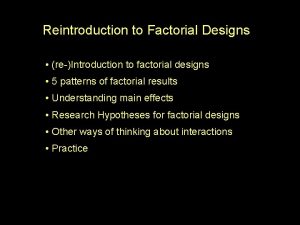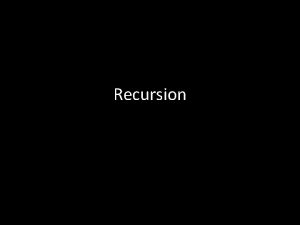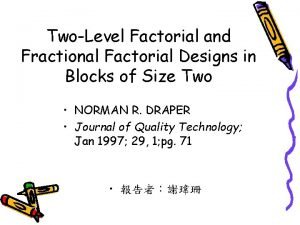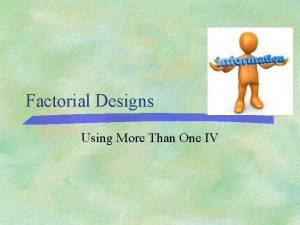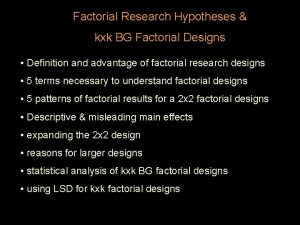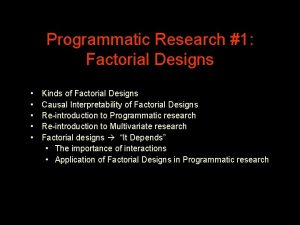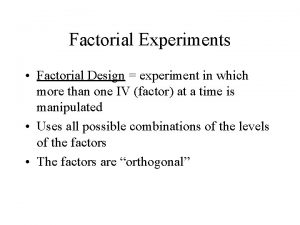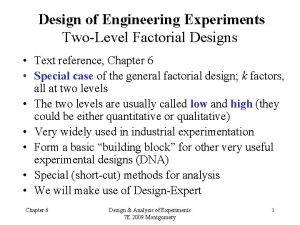Designing Experiments Introduction 2 k factorial designs 2

























































- Slides: 57

Designing Experiments • • • Introduction 2 k factorial designs 2 kr factorial designs 2 k-p fractional factorial designs One-factor experiments Two-factor full factorial design without replications • Two-factor full factorial design with replications • General full factorial designs with k factors

Introduction To Experiment Design • You know your metrics • You know your factors – System parameters that are going to be varied in the study – affect the response variable • You know your levels – The alternative values that the factors will take on • You’ve got your method selected -instrumentation and test workloads • Now what?

Goals in Experiment Design • Obtain maximum information • With minimum work – Typically meaning minimum number of experiments • More experiments aren’t better if you’re the one who has to perform them • Well-designed experiments are also easier to analyze

Experimental Replications • The system under study will be run with varying levels of different factors, potentially with differing workloads • A run with a particular set of levels and other inputs is a replication • Often, you need to do multiple replications with a single set of levels and other inputs – For statistical validation

Interacting Factors • Some factors have effects completely independent of each other – Doubling the factor’s level may halve the response, regardless of other factors • But the effects of some factors depends on the values of other factors – Interacting factors • Presence of interacting factors complicates experimental design

Basic Problem in Designing Experiments • You have chosen some number of factors • They may or may not interact • How can you design an experiment that captures the full range of the levels? – With minimum amount of work • Which combination or combinations of the levels of the factors do you measure?

Common Mistakes in Experimentation • • • Ignoring experimental error Uncontrolled parameters Not isolating effects of different factors One-factor-at-a-time experiment designs Interactions ignored Designs require too many experiments

Types of Experimental Designs • Simple designs • Full factorial design • Fractional factorial design

Experimental Design (l 1, 0, l 1, 1, … , l 1, n 1 -1) x (l 2, 0, l 2, 1, … , l 2, n 2 -1) x … Factor 1 Factor 2 x (lk, 0, lk, 1, … , lk, nk-1) Factor k k different factors, each factor with ni levels

Simple Designs • Vary one factor at a time • For k factors with factor having ni levels - • Assumes factors don’t interact • Usually more effort than required • Don’t use it, usually

fix Simple Designs (l 1, 0, l 1, 1, … , l 1, n-1) x (l 2, 0, l 2, 1, … , l 2, n-1) x … Factor 1 Factor 2 x (lk, 0, lk, 1, … , lk, n-1) Factor k vary

Simple Designs (l 1, 0, l 1, 1, … , l 1, n-1) x (l 2, 0, l 2, 1, … , l 2, n-1) x … Factor 1 x (lk, 0, lk, 1, … , lk, n-1) Factor k Factor 2

Full Factorial Designs • For k factors with factor having ni levels - • Test every possible combination of factors’ levels • Captures full information about interaction • A heck of a lot of work, though

Full Factorial Designs (l 1, 0, l 1, 1, … , l 1, n-1) x (l 2, 0, l 2, 1, … , l 2, n-1) x … Factor 1 x (lk, 0, lk, 1, … , lk, n-1) Factor k Factor 2

Reducing the Work in Full Factorial Designs • Reduce number of levels per factor – Generally a good choice – Especially if you know which factors are most important - use more levels for them • Reduce the number of factors – But don’t drop important ones • Use fractional factorial designs

Fractional Factorial Designs • Only measure some combination of the levels of the factors • Must design carefully to best capture any possible interactions • Less work, but more chance of inaccuracy • Especially useful if some factors are known not to interact

Fractional Factorial Designs (l 1, 0, l 1, 1, … , l 1, n-1) x (l 2, 0, l 2, 1, … , l 2, n-1) x … Factor 1 x (lk, 0, lk, 1, … , lk, n-1) Factor k Factor 2

2 k Factorial Designs • Used to determine the effect of k factors – Each with two alternatives or levels • Often used as a preliminary to a larger performance study – Each factor measured at its maximum and minimum level – Perhaps offering insight on importance and interaction of various factors

Unidirectional Effects • Effects that only increase as the level of a factor increases – Or visa versa • If this characteristic is known to apply, a 2 k factorial design at minimum and maximum levels is useful • Shows whether the factor has a significant effect

22 Factorial Designs • Two factors with two levels each • Simplest kind of factorial experiment design • Concepts developed here generalize • A form of regression can be easily used here • Simplest to show with an example

22 Factorial Design Example • The Time Warp Operating System • Designed to run discrete event simulations in parallel • Using an optimistic method • Goal is fastest possible completion of a given simulation • Usually quality is expressed in terms of speedup • Here, the simpler metric of runtime is used

Factors and Levels for Time Warp Example • First factor - number of nodes used to run the simulation – Vary between 8 and 64 • Second factor - whether or not dynamic load management is used – To migrate work from node to node as load in the simulation changes • Other factors exists, but ignore them for now

Defining Variables for the 22 Factorial TW Example if 8 nodes if 64 nodes if no dynamic load management if dynamic load management used

Sample Data For Example • Single runs of one benchmark simulation 8 Nodes 64 Nodes NO DLM 820 217 DLM 776 197

Regression Model for Example • y = q 0 + q. Ax. A + q. Bx. B + q. ABx. Ax. B • Note this is a nonlinear model 820 = q 0 -q. A - q. B + q. AB 217 = q 0 +q. A - q. B - q. AB 776 = q 0 -q. A + q. B - q. AB 197 = q 0 +q. A + q. B + q. AB

Regression Model, Con’t • 4 equations in 4 unknowns Another way to look at it shown in this table Experiment A B y 1 -1 -1 y 1 2 1 -1 y 2 3 -1 1 y 3 4 1 1 y 4

Solving the Equations q 0 = 1/4(820 + 217 + 776 + 197) = 502. 5 q. A = 1/4(-820 + 217 - 776 + 197) = -295. 5 q. B = 1/4(-820 - 217 + 776 + 197) = -16 q. AB = 1/4(820 - 217 - 776 + 197) = 6 So, y = 502. 5 - 295. 5 x. A - 16 x. B + 6 x. Ax. B

The Sign Table Method • Another way of looking at the problem in a tabular form I A B AB y 1 -1 -1 1 820 1 1 -1 -1 217 1 -1 776 1 1 197 2010 -1182 -64 24 Total 502. 5 -295. 5 -16 6 Total/4

Allocation of Variation for 22 Model • Calculate the sample variance of y Numerator is the SST - total variation SST = 22 q. A 2 + 22 q. B 2 + 22 q. AB 2 • We can use this to explain what causes the variation in y

Terms in the SST • 22 q. A 2 is part of variation explained by the effect of A - SSA • 22 q. B 2 is part of variation explained by the effect of B - SSB • 22 q. AB 2 is part of variation explained by the effect of the interaction of A and B SSAB SST = SSA + SSB + SSAB

Variations in Our Example • • • SST = 350449 SSA = 349281 SSB = 1024 SSAB = 144 We can now calculate the fraction of the total variation caused by each effect (e. g. SSA/SST)

Fractions of Variation in Our Example • Fraction explained by A is 99. 67% • Fraction explained by B is 0. 29% • Fraction explained by the interaction of A and B is 0. 04% • So almost all the variation comes from the number of nodes • So if you want to run faster, apply more nodes, don’t turn on dynamic load management

General 2 k Factorial Designs • Used to explain the effects of k factors, each with two alternatives or levels • 22 factorial designs are a special case • Methods developed there extend to the more general case • But many more possible interactions between pairs (and trios, etc. ) of factors

2 k Factorial Designs With Replications • 2 k factorial designs do not allow for estimation of experimental error – No experiment is ever repeated • But usually experimental error is present – And often it’s important • Handle the issue by replicating experiments • But which to replicate, and how often?

2 kr Factorial Designs • Replicate each experiment r times • Allows quantification of experimental error • Again, easiest to first look at the case of only 2 factors

22 r Factorial Designs • 2 factors, 2 levels each, with r replications at each of the four combinations • y = q 0 + q. Ax. A + q. Bx. B + q. ABx. Ax. B + e • Now we need to compute effects, estimate the errors, and allocate variation • We can also produce confidence intervals for effects and predicted responses

Computing Effects for 22 r Factorial Experiments • We can use the sign table, as before • But instead of single observations, regress off the mean of the r observations • Compute errors for each replication using similar tabular method • Similar methods used for allocation of variance and calculating confidence intervals

Example of 22 r Factorial Design With Replications • Same Time Warp system as before, but with 4 replications at each point (r=4) • No DLM, 8 nodes - 820, 822, 813, 809 • DLM, 8 nodes - 776, 798, 750, 755 • No DLM, 64 nodes - 217, 228, 215, 221 • DLM, 64 nodes - 197, 180, 220, 185

22 r Factorial Example Analysis Matrix I 1 1 A -1 1 B -1 -1 1 1 AB 1 -1 -1 1 y (820, 822, 813, 809) (217, 228, 215, 221) (776, 798, 750, 755) (197, 180, 220, 185) 2001. 5 -1170 -71 21. 5 500. 4 -292. 5 -17. 75 5. 4 q 0= 500. 4 q. A= -292. 5 q. B= -17. 75 q. AB= 5. 4 Mean 816 220. 25 769. 75 195. 5 Total/4

Estimation of Errors for 22 r Factorial Example • Figure differences between predicted and observed values for each replication N yi • Now calculate SSE

Allocating Variation • We can determine the percentage of variation due to each factor’s impact – Just like 2 k designs without replication • But we can also isolate the variation due to experimental errors • Methods are similar to other regression techniques for allocating variation

Variation Allocation in Example • We’ve already figured SSE • We also need SST, SSA, SSB, and SSAB • Also, SST = SSA + SSB + SSAB + SSE • Use same formulae as before for SSA, SSB, and SSAB

Sums of Squares for Example • • SST = SSY - SS 0 = 1, 377, 009. 75 SSA = 1, 368, 900 SSB = 5041 SSAB = 462. 25 Percentage of variation for A is 99. 4% Percentage of variation for B is 0. 4% Percentage of variation for A/B interaction is 0. 03% • And 0. 2% (apx. ) is due to experimental errors

Confidence Intervals For Effects • Computed effects are random variables • Thus, we would like to specify how confident we are that they are correct • Using the usual confidence interval methods • First, must figure Mean Square of Errors

Calculating Variances of Effects • Variance of all effects is the same - • So standard deviation is also the same • In calculations, use t- or z-value for 22 (r-1) degrees of freedom

Calculating Confidence Intervals of Effects for Example • At 90% level, using the t-value for 12 degrees of freedom, 1. 782 • And standard deviation of effects is 3. 68 • Confidence intervals are qi-+(1. 782)(3. 68) • q 0 - (493. 8, 506. 9) • q. A - (-299. 1, -285. 9) • q. B - (-24. 3, -11. 2) • q. AB - (-1. 2, 11. 9)

Predicted Responses • We already have predicted all the means we can predict from this kind of model – We measured four, we can “predict” four • However, we can predict how close we would get to the sample mean if we ran m more experiments

Formula for Predicted Means • For m future experiments, the predicted mean is N y Where N ym

Example of Predicted Means • What would we predict as a confidence interval of the response for no dynamic load management at 8 nodes for 7 more tests? N ym • 90% confidence interval is (811. 6, 820. 4) – We’re 90% confident that the mean would be in this range

Visual Tests for Verifying Assumptions • What assumptions have we been making? – – – Model errors are statistically independent Model errors are additive Errors are normally distributed Errors have constant standard deviation Effects of errors are additive • Which boils down to independent, normally distributed observations with constant variance

Testing for Independent Errors • Compute residuals and make a scatter plot • Trends indicate a dependence of errors on factor levels – But if residuals order of magnitude below predicted response, trends can be ignored • Sometimes a good idea to plot residuals vs. experiments number

Example Plot of Residuals vs. Predicted Response

Example Plot of Residuals Vs. Experiment Number

Testing for Normally Distributed Errors • As usual, do a quantile-quantile chart – Against the normal distribution • If it’s close to linear, this assumption is good

Quantile-Quantile Plot for Example

Assumption of Constant Variance • Checking homoscedasticity • Go back to the scatter plot and check for an even spread

The Scatter Plot, Again
 2k factorial experiments and fractions
2k factorial experiments and fractions Factorial design
Factorial design Ran# calculator
Ran# calculator How to calculate the number of permutations
How to calculate the number of permutations Expericorr
Expericorr Factorial anova
Factorial anova Main effects statistics
Main effects statistics Partial counterbalancing
Partial counterbalancing Descomposición factorial
Descomposición factorial What is 5 factorial
What is 5 factorial 1000 factorial
1000 factorial Factorial haskell
Factorial haskell 8 factorial
8 factorial Definition of factorial
Definition of factorial 11 factorial
11 factorial Factorial anova
Factorial anova Between subjects factorial design
Between subjects factorial design Between subjects design vs within
Between subjects design vs within Modelos factoriales lexicos de la personalidad
Modelos factoriales lexicos de la personalidad Full factorial design
Full factorial design Desain faktorial 2x3
Desain faktorial 2x3 8 factorial
8 factorial 5factorial
5factorial 7팩토리얼
7팩토리얼 Análisis factorial ejemplo
Análisis factorial ejemplo Three way factorial design
Three way factorial design Simple effect in factorial design
Simple effect in factorial design Randomized block design adalah
Randomized block design adalah 22 factorial
22 factorial Factorial randomized block design
Factorial randomized block design Clojure factorial
Clojure factorial In order to understand recursion
In order to understand recursion 23 factorial
23 factorial Is factorial distributive
Is factorial distributive 14 factorial
14 factorial Jmp factorial design
Jmp factorial design Factorial example
Factorial example N n factorial
N n factorial Factorial example
Factorial example (k+2) factorial
(k+2) factorial Fundamental counting principle and factorial notation
Fundamental counting principle and factorial notation 7 factorial
7 factorial Advantages of factorial design slideshare
Advantages of factorial design slideshare How to find prime factors on a casio calculator
How to find prime factors on a casio calculator Factorial shortcut
Factorial shortcut Permutations formula
Permutations formula 3 way factorial design
3 way factorial design Echer's factorial
Echer's factorial Design treatment
Design treatment Factorial rh
Factorial rh Lisp program to find factorial of a number
Lisp program to find factorial of a number 2 kp
2 kp Disinhibition
Disinhibition Factorial in mips
Factorial in mips Spm flexible factorial
Spm flexible factorial Clojure tail recursion
Clojure tail recursion Factorial rh
Factorial rh![[http://earthobservatory.nasa.gov/experiments/biome/] [http://earthobservatory.nasa.gov/experiments/biome/]](data:image/svg+xml,%3Csvg%20xmlns=%22http://www.w3.org/2000/svg%22%20viewBox=%220%200%20200%20200%22%3E%3C/svg%3E) [http://earthobservatory.nasa.gov/experiments/biome/]
[http://earthobservatory.nasa.gov/experiments/biome/]


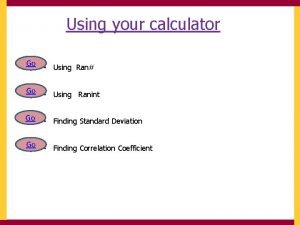
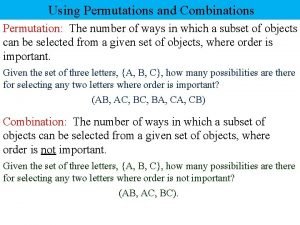


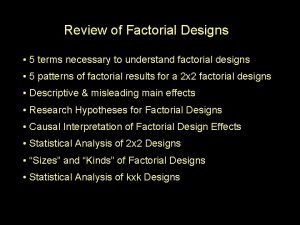
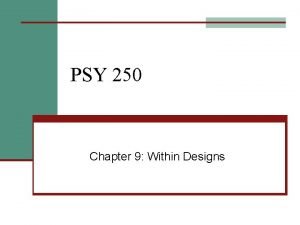


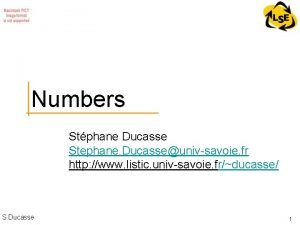
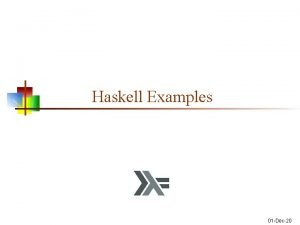

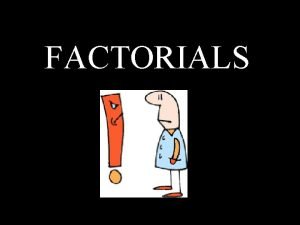
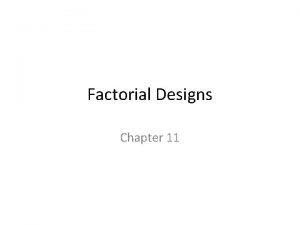
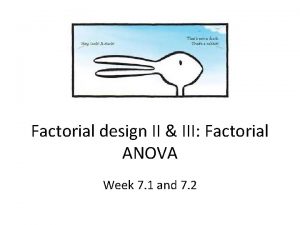
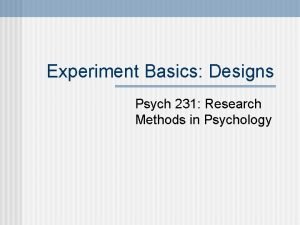
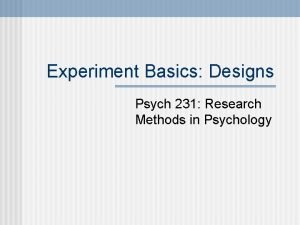
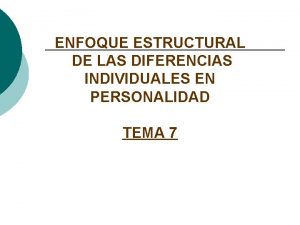


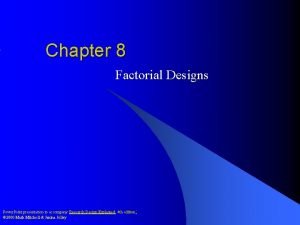
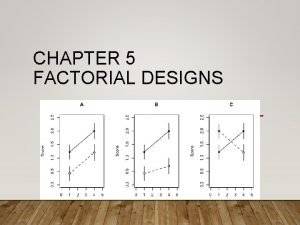

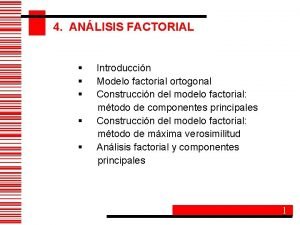


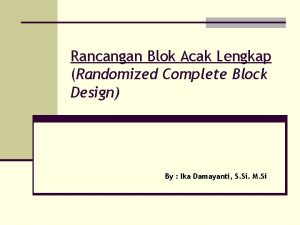

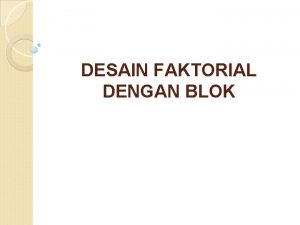
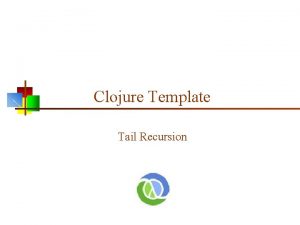
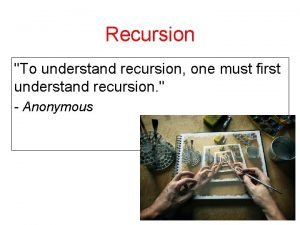
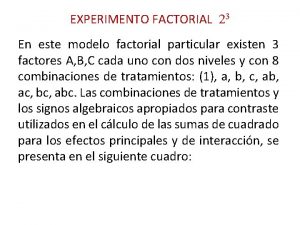

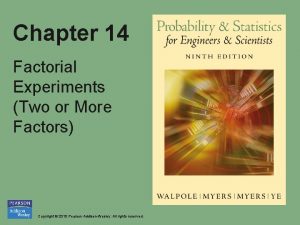
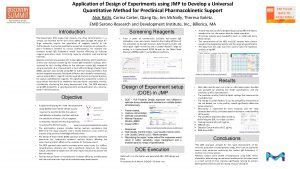
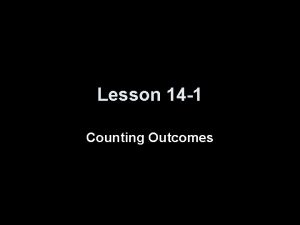
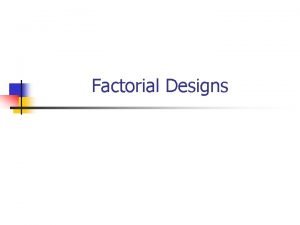

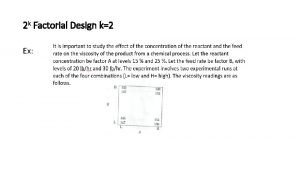
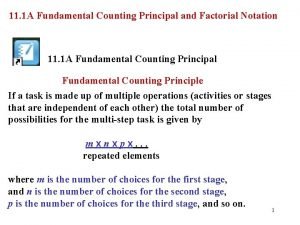
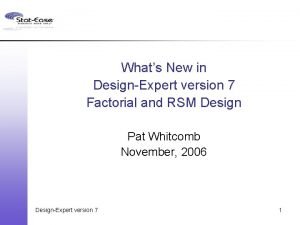
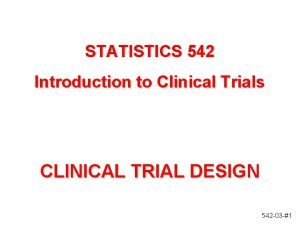

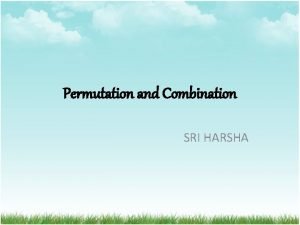
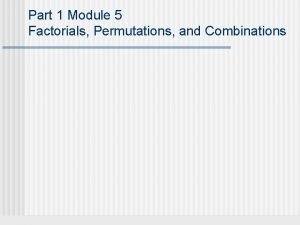
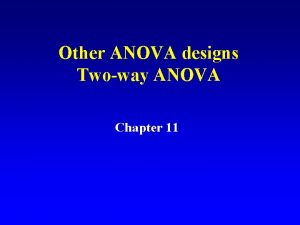
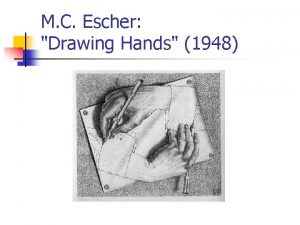
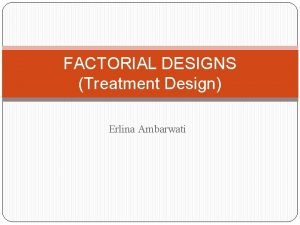
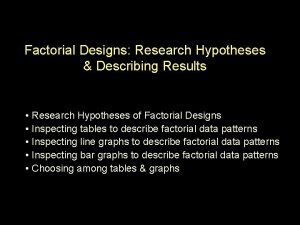



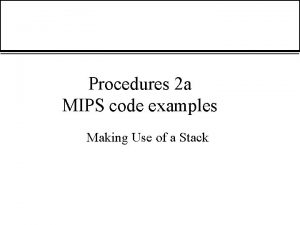

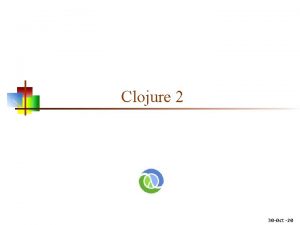
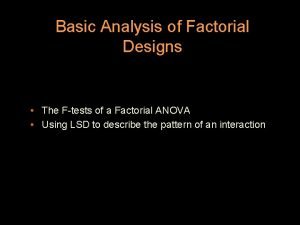
![[http://earthobservatory.nasa.gov/experiments/biome/] [http://earthobservatory.nasa.gov/experiments/biome/]](https://slidetodoc.com/wp-content/uploads/2020/11/1537165_35fb5ecc588217ed14768e866616d64b-300x169.jpg)
